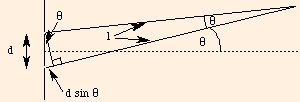
| (prev) | (top) | (next) |
Note that since sin θ ≤ 1, m or (m + 1/2) must be ≤ d / λ.
For double slit diffraction, the intensity is Isingle cos(π d (sin θ) /
λ)2, from which we retrieve the conditions above.
Diffraction
Δpath length = d sin θ = m or (m + 1/2) λ,
respectively, where d is the separation between slits (grating spacing), θ is measured from the normal to the slits
and m is a non-negative integer:

Isingle = Imax (sin(π a (sin θ) / λ) /
(π a (sin θ) / λ))2.
This can only be solved numerically for constructive interference, but for destructive interference we find the path length
Δpath length = a sin θ / (2 m),
where a is the slit width and m is a nonzero integer. This is equivalent to dividing the slit into an even number of parts, each of which acts as a point source.
| (prev) | (top) | (next) |
©2010, Kenneth R. Koehler. All Rights Reserved. This document may be freely reproduced provided that this copyright notice is included.
Please send comments or suggestions to the author.